True, however a port unloads the woofer below the box frequency. Very unwise to drive any woofer below this frequency.
Work with physics, not against it. If you design an optimal enclosure and build it properly, your total "Q" may end up around 0.7071 (Butterworth). You don't have to mess with that at all.
Work with physics, not against it. If you design an optimal enclosure and build it properly, your total "Q" may end up around 0.7071 (Butterworth). You don't have to mess with that at all.
More misunderstanding. A ported speaker has a fourth or sixth order roll off. So that is obviously not what I was talking about. Go and review what I posted and the references before drawing incorrect conclusions.
A sealed enclosure has a second order roll off and that is what the Linkwitz transform can modify. This is working directly with the physics. Many people including myself have applied what I described above to very successful speaker designs. So to simply wave it off is missing opportunities for creating very high performance systems. In my last system build I moved the woofer F3 down to 20 Hz with a Q of 0.5. The bass was amazing.
Imagine Linkwitz, the author of WinISD, miniDSP and many manufacturers using this method, yet it gets flippantly ignored and discounted by hobbyists.
A sealed enclosure has a second order roll off and that is what the Linkwitz transform can modify. This is working directly with the physics. Many people including myself have applied what I described above to very successful speaker designs. So to simply wave it off is missing opportunities for creating very high performance systems. In my last system build I moved the woofer F3 down to 20 Hz with a Q of 0.5. The bass was amazing.
Imagine Linkwitz, the author of WinISD, miniDSP and many manufacturers using this method, yet it gets flippantly ignored and discounted by hobbyists.
Last edited:
Hi anatech, yes!Hi tmuikku,
A speaker system that sounds boomy has to do with speaker system "Q". When you get around unity, you have a hump in the response that becomes worse as the "Q" increases. Properly designed enclosures with the woofer they were designed for are not boomy. The same thing happens with ported or sealed systems.
I'll post another example with amplifier output impedance and system Q, since I'm having the simulator open.
Here is box simulation just some bass driver with some nice looking closed box alignment as an example.
Btw. all simulators assume by default low output impedance amplifier! All drivers are "optimized" for low output impedance use, and all the simulators assume low output impedance as default. High output impedance amp can work just fine, just modify rest of the system accordingly.
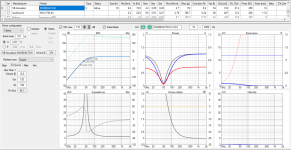
If I now switched and amplifier with low damping factor, output impedance about equal to Re, the electrical damping reduces so system Q increases and we have a peak in response, and this would definitely sound boomy. Note I've increased voltage to compensate sensitivity decrease by adding series resistance. Dashed line in SPL graphs shows the original response of the first image.
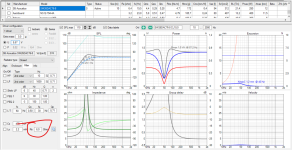
The peak in response at resonance, the system Q, could be tailored with DSP but the mechanical damping to external forces on the system would not change! All we'd do is precondition the input to the system to straighten the response, but if I tapped the cone with my hand it would sound like a drum still no matter the DSP setting because electrical damping is mising (some). Sound by listening music could be fine though, as the resonant peak was EQ:d out. I do not know how significant this difference actually is when listening to music but I could think there is some difference in sound a least in some cases (like loud sub output affecting mid or tweeter that lacks damping, which would change it's electrical parameters and thus affect sound).
System Q is result of everything, electrical and mechanical part all playing out together as one system. Current through voice coil can be manipulated pre amplifier by changing input signal or post amplifier circuit impedance, changing driver motor while mechanical portion is affected adjusting box alignment and filling inside box and so on.
On this image reduced electrical damping is compensated to achieve similar Q, the enclosure is doubled in volume and it's "heavily filled". Resulting system Q ends up similar, reduced electrical damping was patched in by changing mechanical properties of the system.

It would sound somewhat similar, perhaps better due to bandwidth extending lower. Due to increased series impedance it would output less motor distortion into acoustic domain which could also make it sound bit different if not better. Bonus is extreme performance issues like jump resonance should behave better due electrical damping importance is less, and power compression due to heat wouldn't affect circuit current quite as much. Downsides are the double volume box and lots of fill, and it would have this response only with amplifier whose output impedance is ~Re in this case.
As an extra nugget of information not mentioned in forums:
- Q is just how many cycles resonance continues after signal stops. Q = 1 means it's one full cycle at resonant frequency, which in this example system ended up at 35Hz or so.
- A system that is poked with a finger for example, would return into rest at resonant frequency and would settle down within the Q, no matter what the poking frequency was. Hence damping at the resonance is important, it would make teeny little sound at resonant frequency when ever signal stops.
Well, massive post, hopefully not too bad errors with it 🙂
Last edited:
Hi tmuikku,
Yes!
I wasn't aware the "Q" also shows how many cycles a driver would make at resonance of mechanically "poked". Cool. We didn't to things that way. Thanks!
Hi olsond3,
No offense, but many of us are working and do not have time to read references and links. From your text, there is no way to know you referred to sealed systems only. I assumed you could be, but just as easily you may have included those types.
As for higher order roll-off designs, usually only the car market goes with anything above 4th order. Maybe home subs, but they tend to treat the woofer as a piston and force feed it.
One issue with higher order systems is that they become increasingly dependent on woofer characteristics and even air density. Then as the voice coil heats up, the system is no longer tuned. There is always a trade-off between optimal sized boxes and smaller boxes.
Yes!
I wasn't aware the "Q" also shows how many cycles a driver would make at resonance of mechanically "poked". Cool. We didn't to things that way. Thanks!
Hi olsond3,
No offense, but many of us are working and do not have time to read references and links. From your text, there is no way to know you referred to sealed systems only. I assumed you could be, but just as easily you may have included those types.
As for higher order roll-off designs, usually only the car market goes with anything above 4th order. Maybe home subs, but they tend to treat the woofer as a piston and force feed it.
One issue with higher order systems is that they become increasingly dependent on woofer characteristics and even air density. Then as the voice coil heats up, the system is no longer tuned. There is always a trade-off between optimal sized boxes and smaller boxes.
The all important thing to remember: The electrical frequency response as established on the speaker terminals governs the acoustic response. It does not matter how that frequency response was established. With voltage drive (zero output impedance) the electrical FR is flat "by design" as voltage is the impressed entity. With current drive (no electrical damping) the FR would be affected (generally, any other impedance than zero will always affect FR)... but when EQ'd to flat at the terminals then it has the same response as voltage drive, very obviously. This is true for any value and any behavior of output impedance, including negative values and/or frequency dependency.
But what is the actual difference then?
Two things, mainly:
1) Distortion performance, large signal behavior, stability under extreme conditions, power compression etc
2) Damping of external cone excitation. This is the important point because any distortion or recovery from overdrive also falls under external excitation. And the response to that external excitation is governed by the natural damping present, regardless of any applied EQ to the amplifier.
No damping (current drive) means it will ring with the undamped Q, for example after a short moment of excursion overdrive. Normal damping (voltage drive) will give the expected ringing as per chosen box alignment, and extreme damping (negative output impedance almost approaching the VC's DC resistance) will brickwall the cone.
A speaker driver is a velocity-controlled motional feedback system all by itself (with the VC acting as the velocity voltage sensor and as the current-driven actuator at the same time), and the amount of feedback applied is "the damping", literally. A fully velocity controlled cone produces a 6dB/oct rising slope by first principles, until radiation resistance finally starts to dominate and flattens the response.
EDIT: all of this also applies for cases where the input of the amp is EQ'd already even for the standard voltage drive, like with a Linkwitz-Transform. The speaker has no knowledge about this EQ and therefore reacts with it natual Q. If that is a high Q (like speaker in a very undersized closed box) then the transform will fix the apparent response but not the damping and its effect on ringing of the "error response", as explained above.
Summary: A speaker's error response is determined only by the natural Q of the alignent (as given per driver and box parameters together with source impedance). Tailoring the signal response with up-stream EQ to reach a given FR target does not affect the error response.
But what is the actual difference then?
Two things, mainly:
1) Distortion performance, large signal behavior, stability under extreme conditions, power compression etc
2) Damping of external cone excitation. This is the important point because any distortion or recovery from overdrive also falls under external excitation. And the response to that external excitation is governed by the natural damping present, regardless of any applied EQ to the amplifier.
No damping (current drive) means it will ring with the undamped Q, for example after a short moment of excursion overdrive. Normal damping (voltage drive) will give the expected ringing as per chosen box alignment, and extreme damping (negative output impedance almost approaching the VC's DC resistance) will brickwall the cone.
A speaker driver is a velocity-controlled motional feedback system all by itself (with the VC acting as the velocity voltage sensor and as the current-driven actuator at the same time), and the amount of feedback applied is "the damping", literally. A fully velocity controlled cone produces a 6dB/oct rising slope by first principles, until radiation resistance finally starts to dominate and flattens the response.
EDIT: all of this also applies for cases where the input of the amp is EQ'd already even for the standard voltage drive, like with a Linkwitz-Transform. The speaker has no knowledge about this EQ and therefore reacts with it natual Q. If that is a high Q (like speaker in a very undersized closed box) then the transform will fix the apparent response but not the damping and its effect on ringing of the "error response", as explained above.
Summary: A speaker's error response is determined only by the natural Q of the alignent (as given per driver and box parameters together with source impedance). Tailoring the signal response with up-stream EQ to reach a given FR target does not affect the error response.
Last edited:
Hi,I am very grateful to the experts who tried to answer my question.
The truth is I hate passive crossovers, wires, inductors, series resistors... so my amp is an active crossover, active speakers to optimize the wires...
Sure, can't get max DF, but I have low impedance speakers(1.6omh) and Faraday rings
I'm looking for something that has a single punch of bass with little power, I hate rear rumble, and I'm driving a crazy commercial speaker (1.8omh, fs= 30hz, 10cm diameter, with a very short cone travel length)
Regarding the issue of self-oscillation of the amplifier circuit, I took a rather unusual step, which is to use an amplifier without negative feedback, so it will be difficult to oscillate.
so if I understand correctly you sorted out a system that works, except there is some rumble with it and you wanted to fix that?
As per discussion so far, you might have already noticed that instead of adding electrical damping you could increase mechanical damping.
Few examples you could do without a rebuild:
- if it is a reflex box make sure there is high pass filter to cut lows below tuning.
- regardless of box type you could increase fill inside the box to lower the Q, fill the box completely.
- you could introduce leak(s) to the box. If you don't want to drill a hole to it you could add shim/washers between driver and the box, or if there is a connector panel or something. Make it leak as much as needed to get the sound nice.
In addition, if you can rebuild the box you could increase it's volume, in combination with the above techniques.
In other words, use box designer with the amplifier output impedance taken into account to see the response. I bet all box design software default settings are for very low output impedance.
Hope it helps!🙂
Box with issue due to high amplifier output impedance.
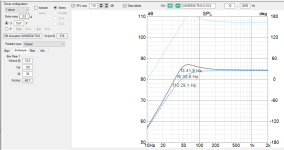
Fixed by making the box leak:
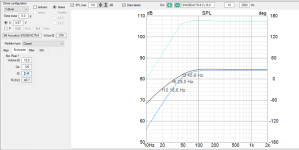
Fixed by adding heavy stuffing:
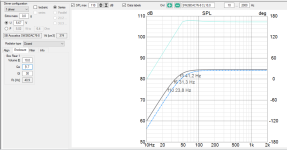
Fixed by increasing volume:
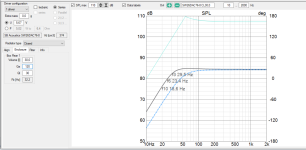
Best and simplest fix is likely to add stuffing and make it leak. I would also make sure there is a high pass filter to limit excursion, bad sound could be just the driver getting haywire if it's a low excursion one.
Last edited:
Wouldn't it be more accurate to express this as: must follow...to produce a pressure the speaker cone must accelerate proportional to the recorded signal.
//
Thanks for the exquisite post! And so I will continue to build closed box bass systems thank you! 🙂Tailoring the signal response with up-stream EQ to reach a given FR target does not affect the error response.
//
One more: Except for an overdrive case, will current drive lower distortion in a driver? And if so, why/how?But what is the actual difference then?
//
I think we already have quite a lot of threads on current drive here where you will find the answers. No simple answers, though.One more: Except for an overdrive case, will current drive lower distortion in a driver? And if so, why/how?
This is my thinking too. There is a ‘school of thought’ about this; and the PASS F4 comes to mind. No feedback, and yet, DF is high enough for normal speakers loads 3-12 ohms. Stable. And liked.1. Add multiple parallel devices to the outputs
2. Reduce or remove emitter resistors.
3. Raise bias
Because it is a follower, essentially you need a driver (preamp?) with enough output like 12V RMS. There in that community there are some quite simple to elaborate drivers. BJT based, FET based, jFET based, opamp based (yes there are opamps that can really rock the boat). And a tube even like 300B will deliver a charm. Yes, there are enough ideas to roll the F4.
Last edited:
A follower uses 100% local feedback, so you mean "no global feedback". In a follower the emitter is at the output voltage, the base at the input voltage, and the collector current dependent mainly on Vbe, so the transistor response is controlled by input voltage - output voltage, i.e. negative feedback that can correct for output disturbance (i.e. damping).
That is an excellent question. Specifically, no. I had the very same misconception for a long time.Wouldn't it be more accurate to express this as: must followaccelerate proportional tothe recorded signal. To "accelerate proportionally" would mean a non linear function i.e. the 2nd derivate? Or does ot mean the same thing but just a more fancy way of expressing it<?
//
Maybe 15 years ago I decided to make a servo drive speaker so I started reading everything I could find about it. For that to work you have to measure the motion of the cone and then compare the measurement with the input signal and make corrections based on the difference. Studying commercial servo subwoofers I found they had an accelerometer on the cone. The signal from that is directly subtracted from the in coming audio signal in these systems and the error signal goes to the amplifier.
If you google search "acoustic pressure related to cone acceleration" you will find many references that state that the acoustic pressure produced by a loudspeaker cone is due to the acceleration of the cone. It's not the position, not the velocity, but the acceleration. It took me a while to wrap my head around it. Many statements made in the popular high end audio magazines over the years lead me and many others to believe some other non-sense. The whole low impedance amplifier puts a grip on the woofer motion. That's only sort of true when the woofer is operating below its box resonance and has lost track of the audio signal and is producing a velocity (or is it position?) proportional to the signal and not an acceleration, hence the low end roll off. The book I referenced in the earlier post goes into detail on the physics and acoustics. As the motor force as low frequencies or DC is opposed by the suspension spring, I guess the position of the cone is tracing the input signal below the resonance where it is compliance controlled. The whole spring F = kx spring constant * displacement being balanced by motor output F = Bli magnet field * wire length * current . Above the resonance when "mass controlled" F = m a mass * acceleration being balanced by motor output F = Bli. Where the current is i = V / z amplifier output voltage / speaker impedance
Last edited:
That is interesting. Those speakers that are 'lightest', think Lowther, electrostats, they are easiest to accelerate, I think. And often regarded as good sounding.We listen to acceleration.
Aha. So we are actually listening to the second derivate, the acceleration, of each time of the recorded music signal? Is an ordinary recording also an acceleration recording or is there an asymmetric relation here between recording and reproduction?Specifically, no
//
OP mentioned a 1.6 ohm load.
You want a amplifier with a lot of output transistors.
There is a minimum amount needed, and then overkill for relentless drive into low impedance difficult loads.
Then of course a real power supply that accepts such a ridiculous load.
No offense 1.6 ohms is not very ideal, Even 6 to 8 ohms not ideal, but far far more friendly than 1.6 ohms.
Even with 8 ohm loads a redundant amount of output devices, will give way better drive and less distortion.
Other than that A speaker with more control has a powerful motor.
If Qts is getting in the upper .4 or .5 rather weak motor.
The enclosure needs to be rather large to make up for it.
Comes down to basics with audio.
Amplifiers with generous amounts of output devices and power supplies.
And speakers with generous amounts of control with powerful magnets.
.3 to low .4 Qts
Whatever mechanical properties it has.
The box should be large enough for same old known .707 Q
Software or plugins wont change that, these are physical realities.
You want a amplifier with a lot of output transistors.
There is a minimum amount needed, and then overkill for relentless drive into low impedance difficult loads.
Then of course a real power supply that accepts such a ridiculous load.
No offense 1.6 ohms is not very ideal, Even 6 to 8 ohms not ideal, but far far more friendly than 1.6 ohms.
Even with 8 ohm loads a redundant amount of output devices, will give way better drive and less distortion.
Other than that A speaker with more control has a powerful motor.
If Qts is getting in the upper .4 or .5 rather weak motor.
The enclosure needs to be rather large to make up for it.
Comes down to basics with audio.
Amplifiers with generous amounts of output devices and power supplies.
And speakers with generous amounts of control with powerful magnets.
.3 to low .4 Qts
Whatever mechanical properties it has.
The box should be large enough for same old known .707 Q
Software or plugins wont change that, these are physical realities.
Hi olsond3,
Yes, for a servo system the acceleration compared to the input signal is your correction needed. The force required will be the velocity of the cone against the air mass, plus whatever correction is needed. As long as the amplifier can accurately supply that, you're good.
Early servo subs may have also used a coil mounted ahead of the woofer voice coil. One trade-off you make with a servo is the space in the voice coil lost from the motor to the servo coil, and the added dead mass.
Yes, for a servo system the acceleration compared to the input signal is your correction needed. The force required will be the velocity of the cone against the air mass, plus whatever correction is needed. As long as the amplifier can accurately supply that, you're good.
Early servo subs may have also used a coil mounted ahead of the woofer voice coil. One trade-off you make with a servo is the space in the voice coil lost from the motor to the servo coil, and the added dead mass.
A cone or diaphragm with lower mass and the same motor strength will simply require less power to achieve the same SPL level (it's more efficient) A low mass cone often has less stiffness and will bend or have lower damping than a higher mass cone.That is interesting. Those speakers that are 'lightest', think Lowther, electrostats, they are easiest to accelerate, I think. And often regarded as good sounding.
The recorded signal is the pressure value. If there was an asymmetric relation between recording and playback there would be a constant slope to the frequency response of the end to end system. This would be easily corrected with an integrator or differentiator in the signal chain depending on the sign of the slope.Aha. So we are actually listening to the second derivate, the acceleration, of each time of the recorded music signal? Is an ordinary recording also an acceleration recording or is there an asymmetric relation here between recording and reproduction?
//
anatech:
"The force required will be the velocity of the cone against the air mass, plus whatever correction is needed."
It depends on what frequency you are looking at. Above the resonance, where the speaker is designed to produce most of the output, (AKA the mass controlled region) the large majority of force from the motor is opposed by the equal and opposite force from accelerating the mass of the cone and accelerating the adjacent coupled air mass. You will see cone mass specifications for a loudspeaker includes air mass for making calculations of the TS parameters for box sizing etc. A look at the Thiel & Small papers or the book I referenced will show the equations of motion in detail. The mass controlled and compliance controlled regions of operation of a speaker are well known and documented.
I suppose the "damping controlled region" would be right at the resonance frequency and would be reflected in the Q. To the extent that the cone is moving through the air, there would be dynamic pressure drag term due to the cone velocity, which would be a damping factor in the equations of motion. This term becomes significant when a large amount of acoustic damping material is placed in a box behind the driver. Damping material opposes the velocity of the air moving through it. On a raw driver in free air I believe this term is combine with and possibly swamped out by the mechanical damping (opposing force proportional to velocity) due to the bending of the lossy spider and surround materials. The large variation in Q mechanical of various drivers of the same size shows how the material selection can change this.
Below the resonance, the compliance controlled region, the force of the motor is for the most part opposed by the suspension spring force due to displacement.
To me it seems to be the situation... acc vs. press.... but I probably don't have all the needed insight to come to the correct conclusion... please help 🙂If there was an asymmetric relation
//
Usually (depends on the microphone) we listen to a pressure recording - if I'm not mistaken.Is an ordinary recording also an acceleration recording
Pressure has a direct relation to acceleration.
Thus we hear - more or less - what has been recorded.
Edit: should have read olsond's post before ...
- Home
- General Interest
- Everything Else
- How to get high damping without amplifier feedback interference